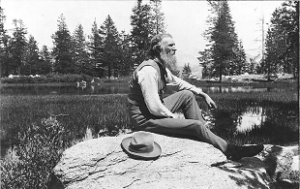National Parks play an important role in many of our lives. During the centennial year of the National Park Service in 2016, National Parks had a record breaking 331 million visits. Most of us have treasured memories of family vacations and school field trips to parks that provide recreational opportunities, but also represent our country’s efforts to preserve and protect the natural environment. Maryland Humanities explores the history of America’s parks in one of the over sixty Teaching with Primary Resources Inquiry Kits.

The Inquiry Kit “Conservation and the Creation of National Parks” contains fascinating artifacts from the extensive Library of Congress digital collection. The kit begins with a vintage map of the Grand Canyon National Park and a photograph of John Muir, founder of the Sierra Club. Muir was a Scottish-American environmentalist who wrote extensively about the natural world. One of his greatest accomplishments was convincing Congress to declare the area around Yosemite Valley a National Park in 1890.
John Muir took President Theodore Roosevelt camping in Yosemite in 1903 and turned the already nature-loving president into an ardent conservationist. Roosevelt founded the National Forestry Service in 1906, and established 230 million acres of public land during his presidency. His love of conservation is expressed in the silent film “Roosevelt, Friend of the Birds,” included in this TPS Inquiry Kit. The film follows Roosevelt on a visit to a bird sanctuary off the coast of Louisiana in 1915. The rare footage includes shots of Roosevelt tramping through marshes and lounging on a beach, watching birds.
Theodore Roosevelt believed that public lands should be used for the public good, which explains his enthusiasm for now-controversial “Desert Reclamation.” Roosevelt supported numerous dam projects to irrigate western deserts and turn them into agricultural land. In the film “The Roosevelt Dam,” footage of dam construction is paired with scenes of the former president speaking about the importance of reclamation. The film is particularly fascinating in light of debates over western water use that continue today.
The “Conservation and the Creation of National Parks” Inquiry Kit concludes with a link to a Library of Congress website devoted to the Congressional debates over the National Park Service in 1916, with links to many more incredible documents found within the Library. This Inquiry Kit is an enjoyable dive into National Park history for any fan of the outdoors, and it provides students a great start for a National History Day project or other research assignment.
TPS Inquiry Kits are the result of a partnership between Maryland Humanities, Maryland Public Television, and the Maryland State Department of Education, and are funded by the Library of Congress Teaching with Primary Sources program. This new collection of Inquiry Kits allows students to select a research topic of interest and evaluate themed primary sources from the Library of Congress. From life in the early American colonies to the modern-day life in the United States, the Inquiry Kits examine social studies/history themes and align with Maryland curriculum units. Inquiry Kits are great for use in classroom activities, or as starter kits for History Day projects.
Disclaimer: The views and opinions expressed on our blog do not necessarily reflect the views or position of Maryland Humanities or our funders.

